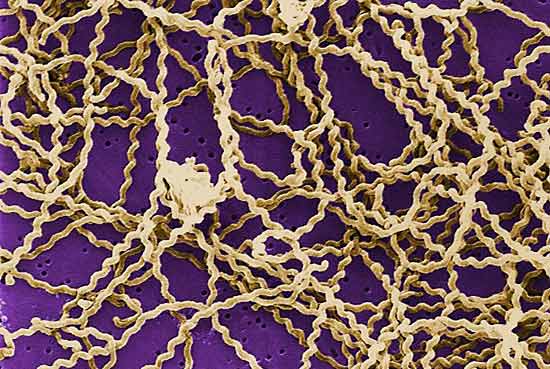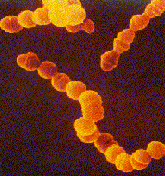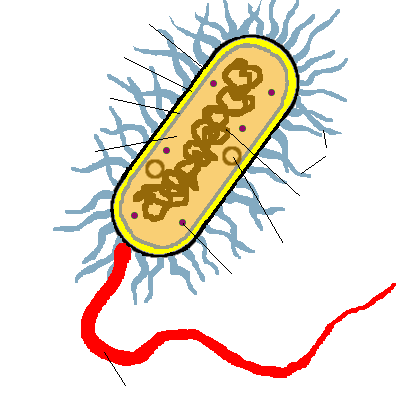IT's All About A Bacterial Cell!

This quiz will test your knowledge of Bacteria structure and function. Let's start this quiz now!
- 1.
Bacteria can be which of the following shapes?
- A.
Bacillus, Spirilia, Canadiaus
- B.
Bacillus, Spirilia, Conpus
- C.
Bacillus, Spirilia, Coccus
- D.
Bacillus, Quadrain, Coccus
- E.
Bacillus, Quadrain, Conus
Correct Answer
C. Bacillus, Spirilia, CoccusExplanation
Bacteria can have different shapes, and the correct answer lists three possible shapes: bacillus, spirilla, and coccus. Bacillus refers to rod-shaped bacteria, spirilla refers to spiral-shaped bacteria, and coccus refers to spherical or round-shaped bacteria. These are all common shapes that bacteria can exhibit.Rate this question:
-
- 2.
A bacteria named Staphylobaccilus would be: (hint, what does staph mean and what does baccilus mean?
- A.
Rod shapped and clustered
- B.
Rod shapped and in chains
- C.
Sphere shapped and clustered
- D.
Sphere shapped and in chains
- E.
Spiral shapped and clustered
Correct Answer
A. Rod shapped and clusteredExplanation
The word "staph" in Staphylobaccilus refers to the genus Staphylococcus, which are bacteria that are typically rod-shaped. The term "bacillus" means rod-shaped as well. Therefore, a bacteria named Staphylobaccilus would be rod-shaped. Additionally, the term "clustered" suggests that the bacteria are found in clusters rather than in chains, spheres, or spirals.Rate this question:
-
- 3.
Gram Positive bacteria will stain:
- A.
Amber
- B.
Brown
- C.
Pink
- D.
Purple
- E.
Teal
Correct Answer
D. PurpleExplanation
Gram positive bacteria will stain purple. This is because they have a thick peptidoglycan layer in their cell wall, which retains the crystal violet stain during the Gram staining process. The stain is then fixed with iodine and decolorized with alcohol, causing the purple color to remain in gram positive bacteria. In contrast, gram negative bacteria have a thinner peptidoglycan layer and an outer membrane, which allows the stain to be washed away during the decolorization step, resulting in a pink color when counterstained with safranin.Rate this question:
-
- 4.
This form of bacterial reprodcution produces genetic clones of the original bacteria cell
- A.
Conjugation
- B.
Endospore production
- C.
Binary fission
- D.
Binary fusion
- E.
None of the above
Correct Answer
C. Binary fissionExplanation
Binary fission is a form of bacterial reproduction where a single cell divides into two identical daughter cells. This process produces genetic clones of the original bacteria cell because the genetic material is replicated and evenly distributed between the two daughter cells. Conjugation involves the transfer of genetic material between two bacterial cells, while endospore production is a method of bacterial survival under unfavorable conditions. Binary fusion is not a recognized form of bacterial reproduction. Therefore, the correct answer is binary fission.Rate this question:
-
- 5.
The outermost layer of a bacterial cell is called the _________________________
Correct Answer
capsule
capsleExplanation
The outermost layer of a bacterial cell is called the capsule.Rate this question:
- 6.
When you collected bacteria from around the school, their main source of food was:
- A.
Particles in the air contained within the petri dish
- B.
Other microbes that were brought into the dish with the bacteria sample
- C.
Organic material that followed them from where they were collected
- D.
The agar in the petri dish
- E.
All of the above
Correct Answer
D. The agar in the petri dishExplanation
The agar in the petri dish is the main source of food for the collected bacteria. Agar is a gelatinous substance derived from seaweed and it provides essential nutrients for bacterial growth. The other options, such as particles in the air, other microbes, and organic material, may also contribute to the bacteria's food source, but the agar is the primary and most significant source of nutrition in the petri dish.Rate this question:
-
- 7.
Bacteria can be found:
- A.
In yogurt, vitamins, and cheese
- B.
In the intestines of animals to help them digest food
- C.
On plant roots to help them turn nitrogen gas to usable nitrogen
- D.
All of the above
- E.
None of the above
Correct Answer
D. All of the aboveExplanation
Bacteria can be found in yogurt, vitamins, and cheese as they play a crucial role in the fermentation process. They are also present in the intestines of animals where they aid in the digestion of food. Additionally, bacteria can be found on plant roots, specifically in nodules, where they convert nitrogen gas into a usable form for plants. Therefore, the correct answer is "all of the above" as bacteria can be found in all of these mentioned places.Rate this question:
-
- 8.
What is the main purpose of a flagella on a bacterial cell?
- A.
Obtaining and digesting food
- B.
Locomotion (movement)
- C.
Attaching to another cell for entry
- D.
It has no purpose, it is a vestigal structure
- E.
It looks cool!
Correct Answer
B. Locomotion (movement)Explanation
The main purpose of a flagella on a bacterial cell is locomotion or movement. Flagella are long, whip-like structures that extend from the cell surface and enable bacteria to move towards favorable environments or away from harmful substances. This movement is essential for bacterial survival and allows them to explore their surroundings, find nutrients, and escape from potential threats.Rate this question:
-
- 9.
We heat up and refridgerate food because it helps to:
- A.
It helps us avoid bacterial growth that could make us ill
- B.
It helps us avoid viral growth that could make us ill
- C.
It allows us to prevent endospores from forming and being transported into the air for other transport
- D.
All of the above
- E.
None of the above
Correct Answer
A. It helps us avoid bacterial growth that could make us illExplanation
Heating up and refrigerating food helps us avoid bacterial growth that could make us ill. Bacteria multiply rapidly in warm environments, so heating up food kills or inhibits the growth of bacteria. Refrigeration slows down the growth of bacteria, as they thrive at temperatures between 40°F (4°C) and 140°F (60°C). By preventing bacterial growth, we reduce the risk of foodborne illnesses caused by consuming contaminated food.Rate this question:
-
- 10.
In sexual reprodcution (conjugation) bacteria exchange information throug the _________ of the bacteria
- A.
Flagella
- B.
Cell wall
- C.
Pilli
- D.
Capsule
- E.
Chromosome
Correct Answer
C. PilliExplanation
In sexual reproduction (conjugation), bacteria exchange genetic information through the pili. Pili are hair-like structures that extend from the surface of bacteria and are involved in the transfer of DNA between cells. They allow the bacteria to adhere to surfaces and facilitate the exchange of genetic material, which can lead to genetic variation and evolution.Rate this question:
-
- 11.
_________________ is the kindgom that all of the bacteria we collected are found in
Correct Answer
Eubacteria
Ubacteria
EbacteriaExplanation
Eubacteria is the correct answer because it is the kingdom that all of the bacteria we collected are found in.Rate this question:
- 12.
Bacteria found in extreme environments are found in this kingdom
- A.
Eubacteria
- B.
Ubacteria
- C.
Archebacteria
- D.
Fungi
- E.
Protista
Correct Answer
C. ArchebacteriaExplanation
Archebacteria, also known as Archaea, are a group of microorganisms that are found in extreme environments such as hot springs, deep-sea hydrothermal vents, and salt lakes. These bacteria have unique characteristics that allow them to survive in these harsh conditions, such as the ability to tolerate high temperatures, high salinity, and acidic or alkaline pH levels. Therefore, the correct answer is Archebacteria.Rate this question:
-
- 13.
This would be an example of what shape of bacteria
- A.
Bacillus
- B.
Spirillia
- C.
Coccus
- D.
Quadrian
- E.
None of the above
Correct Answer
B. SpirilliaExplanation
The correct answer is Spirillia. This is because Spirillia is a shape of bacteria that is characterized by a spiral or helical shape. Bacillus, Coccus, and Quadrian are other shapes of bacteria, but they do not match the description given in the question. Therefore, the correct answer is Spirillia.Rate this question:
-
- 14.
Name this bacteria: Hint- it is round and in a chain form
- A.
Staphylococci
- B.
Streptococci
- C.
Diplococci
- D.
Staphylobaccillus
- E.
Streptobaccillus
Correct Answer
B. StreptococciExplanation
Streptococci is the correct answer because it is a type of bacteria that is round and forms chains. Staphylococci, on the other hand, are round bacteria that form clusters. Diplococci are round bacteria that form pairs. Staphylobaccillus and Streptobaccillus are not valid names for bacteria.Rate this question:
-
- 15.
What are the purple dots on this picture??
- A.
Ribosomes
- B.
Chromosome
- C.
Pilli
- D.
Riniculues
- E.
Capsules
Correct Answer
A. RibosomesExplanation
The purple dots on the picture are ribosomes. Ribosomes are small, round structures found in cells that are responsible for protein synthesis. They can be found in the cytoplasm or attached to the endoplasmic reticulum.Rate this question:
-
- 16.
It is most effective to wash your hands
- A.
In warm water
- B.
In warm water with soap
- C.
In cold water
- D.
Any of the above are effective
- E.
Non of the above are effective
Correct Answer
B. In warm water with soapExplanation
Washing hands in warm water with soap is the most effective method because warm water helps to remove dirt and oil from the skin more effectively than cold water. Soap helps to break down and remove germs and bacteria from the hands, further enhancing the effectiveness of handwashing. Cold water alone may not be as effective in removing dirt and germs, while washing hands without soap may not adequately eliminate bacteria and viruses. Therefore, washing hands in warm water with soap is the best option for thorough hand hygiene.Rate this question:
-
- 17.
For this one the answer is "Biology"
- A.
English
- B.
P.E.
- C.
Math
- D.
Lunch
- E.
Biology
Correct Answer
E. BiologyExplanation
The given list appears to be a schedule or a sequence of subjects or activities in a school day. The answer "Biology" is the last subject/activity mentioned in the list, indicating that it is the final item in the schedule. Therefore, the correct answer is "Biology".Rate this question:
-
Quiz Review Timeline +
Our quizzes are rigorously reviewed, monitored and continuously updated by our expert board to maintain accuracy, relevance, and timeliness.
-
Current Version
-
Mar 22, 2023Quiz Edited by
ProProfs Editorial Team -
May 03, 2010Quiz Created by
Wolf0901
 Back to top
Back to top





